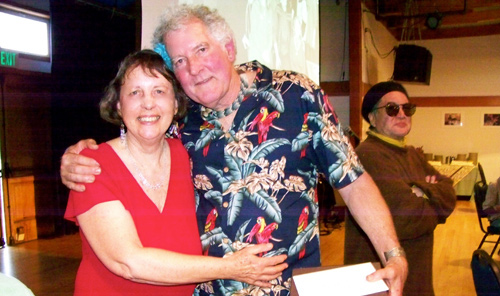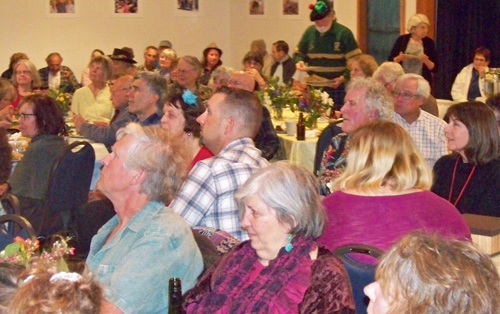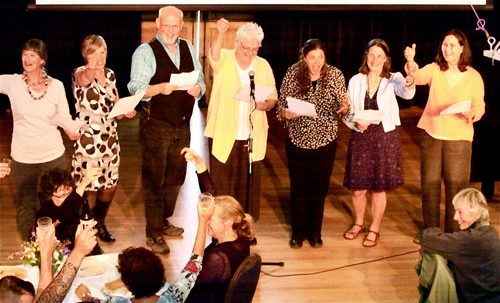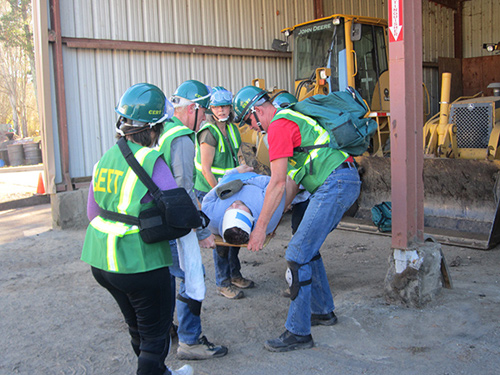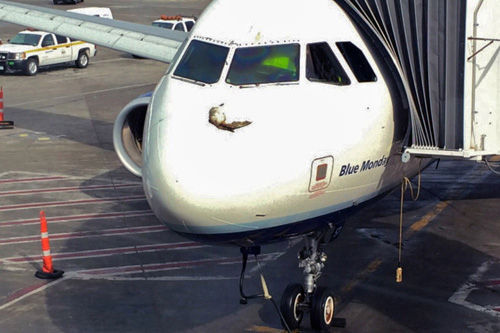Just over a year ago, Tomales Regional History Center published my second book (coauthored by Jacoba Charles) The Light on the Coast: 65 Years of News Big and Small as Reported in The Point Reyes Light. The third printing is almost sold out, and it may soon be time for a fourth.
To whet the appetite of those of you who haven’t yet picked up the book, here’s a column from it that was originally written 30 years ago when these ruminations were in print labeled “Sparsely Sage and Timely.” Back then, The Light was published in Point Reyes Station’s Old Creamery Building with the newsroom on the second floor.
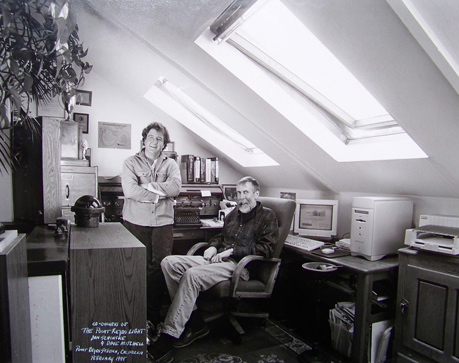
The Light’s former newsroom with my partner Don Schinske standing and me sitting at my desk. Back then I wrote and edited text on a computer but wrote headlines on an old-fashioned, standard typewriter and then hand-carried them to the typesetter downstairs. © 1998 Art Rogers/Pt. Reyes, who contributed 10 photos to “The Light on the Coast.”
It’s late in the evening, and I’m sitting at a rolltop desk in the newsroom listening to a dog barking a block or two away. Every minute or so, I can hear a car come down Highway 1 into town and turn the corner by the bank. Once in awhile, a car heads up the hill, probably someone who just stopped in town for a drink before heading home.
When I first arrived in Point Reyes Station in 1975, I slept for a couple of months in the newsroom of the old Light building [across the street from today’s Whale of a Deli]. Despite being at a bend and intersection of a state highway, the spot was reasonably tranquil, at least after midnight. Oh, there’d be a brief flurry of shouting when the bars closed and the sound of unsteady feet scuffing past the window, but for a place to spend the night, a room on Point Reyes Station’s main street wasn’t that bad.
When I was in college and had yet to live in a small town, I chanced to read Winesburg, Ohio, Sherwood Anderson’s sketches of small-town life. In one of the tales, The Teacher, Anderson describes a late evening when there are only three people awake in Winesburg.
Naturally, one of the three was a reporter in the newsroom of the town’s weekly newspaper who pretended to be at work on the writing of a story. At last, the reporter too goes home and to bed. “Then he slept,” wrote Anderson, “and in all Winesburg, he was the last soul on that winter night to go to sleep.”
As a college student used to cities and suburbs, I found the concept of a town where no one was awake so strange that I briefly wondered if such a place were possible. Now, 20 years later, I find myself living in a town where on occasion late at night I probably am the only person downtown who isn’t asleep.
Of course, there are some nights when the tranquility of even this sleeping town is disturbed. A few years ago, Michael Jayson told me at the time, he had been asleep in an apartment over the old Dance Palace [where Cabaline is today] when he was awakened by the thunder of hooves below his window on Third Street.
A dog had gotten into rancher Waldo Giacomini’s pasture [now the Giacomini Wetlands] and began to worry a herd of cows, which then gave chase to the dog, crashing through a barbed-wire fence in their pursuit.
The next morning, Jayson told in amazement of having seen the stampede gallop up Third to Point Reyes Station’s main street and then turn east. At the T-intersection where the main street ends in front of Cheda’s Market, the herd wheeled around and headed back west.
As it happened, a fight had spilled out of the Western Saloon and into the intersection at Second Street where it had caught the eye of a bartender across main street at the Two Ball Inn [now the Station House Café. He called sheriff’s deputies, who had just arrived to break up the brawl when the stampede did it for them.
With a herd of cows galloping toward them, the two brawlers, along with onlookers, scattered. After the stampede had passed, however, the brawlers returned to the intersection only to have the stampede come through again on its second pass.
This time as the crowd dashed for safety, the two combatants kept on running, as did a number of Giacomini’s cows once the stampede reached the west end of main street. It was two days before the rancher got them all rounded up again. “I wish some people would keep their dogs tied up,” he grumbled to me afterward.
Down the street, the dog is barking again,probably bragging about the night when he alone provoked 50 head of Waldo Giacomini’s dairy cows to stampede through the middle of town. April 11, 1985

Nancy Hemmingway and her husband Bruce Mitchell during a retirement party in her honor Saturday.
Inverness resident Nancy Hemmingway, who retired at the end of last month after 42 years as the town librarian, received a series of emotional tributes, some of them downright tearful, during a gala Saturday in Point Reyes Station’s Dance Palace.
A series of speakers commented on how well Nancy got along with library patrons and with colleagues in the Marin County Free Library System. Her concern for children drew particular praise.

So many people showed up to honor Nancy that the Dance Palace was almost as packed as it is each November for the Community Thanksgiving Dinner.
“Nancy Hemmingway has been the Inverness librarian longer than the Inverness library has been at its current location,” The Point Reyes Light reported on March 20.
“She’s devoted more than half her life to this community, in more ways than one,” The Light quoted Bonny White, the library’s West Marin branch manager, as saying. “Nancy is irreplaceable. She’s one of the most gracious people I’ve ever met in my life, either in library service or out of it. We have been so lucky.”

An ad hoc group calling themselves the West Marin Library Singers serenaded Nancy with “I’ve Been Working in the Library” sung to the tune of “I’ve Been Working on the Railroad.” Branch manager Bonny White (center) emceed the celebration.

Dance Palace Community Center founders (from left): Kate Adams, Carol Friedman, Michael Jayson, and Nancy Hemmingway in 1971. The photo appears in my new book, The Light on the Coast, courtesy of the Friedman-Jayson family collection. Saturday’s event ended, appropriately enough, with everyone being invited to dance. ____________________________________________________________________
Learn to Help! Have fun! Get dirty!
By West Marin Disaster Council Coordinator Anne Sands
What would you do in a disaster if no help were available?
Following a disaster event, such as a wildland fire, flood, tsunami or earthquake, West Marin’s first responders, firefighters, paramedics, and law enforcement, expect to be overwhelmed. We need to be prepared to take care of ourselves for at least three days and maybe longer.
Community Emergency Response Team (CERT) training is a national program that teaches you how to take care of yourself and help your community until first responders are able to assist.

Practicing extricating a victim from a damaged building during CERT training last January in Nicasio.
This 18-hour training, a two-day class taught on Saturdays by our local firefighters, teaches preparedness and survival skills that you can use to help you, your family, and your community survive after a disaster. Completion of the training qualifies you to be a volunteer Community Emergency Response Team (CERT)Â member and makes you an official Disaster Service Worker (covered by worker’s compensation).
How you participate is completely up to you and your level of comfort. No special skills or experience are needed in order to be a CERT member. Don’t let age stop you. We’ve trained participants from teenagers to over-70 year olds. The important thing you bring to the class is a commitment to be ready for the next disaster.

Practicing transporting a victim during the training in Nicasio.
What will you learn?
CERTs are trained to work in teams, organize a command post, set up a triage area, and perform basic first aid, such as identifying symptoms of shock, splinting limbs, and stopping bleeding.
CERTs learn about when and how, to extinguish a small fire using a fire extinguisher.
CERTs learn light search and rescue (SAR) techniques to find victims and safely transport them to the triage area.
CERTs record activities and information to accurately report to the first responders when they arrive.
This isn’t just a lecture class. There are plenty of hand-on experiences and disaster simulations to practice your newly learned disaster preparedness skills. 
Congratulations to the 23 graduates of the West Marin CERT class held in January. They are: Lynn Axelrod, Troy Clemons, Diane Doubleday, Walter Earle, Russ Faure-Brac, Gail Fechter, Jerry Feichert, Margaret Graham, Ann Griffin, Graham Hawkes, Oliver Hawkes, Peter Herbert, Don Holmlund, Shirley Holmlund, Paula Linton, Stella Petrakis-Rinne, Risto Rinne, Alison Romano, Anne Sands, Julie Siegel, Jacquie Waterman, Maureen Williams, and Luisa Young.
The next CERT class in West Marin will be Saturdays May 17 and 31 at the Marin County Corporation Yard in Nicasio. Learn more about CERT and register for this or another CERT class at www.readymarin.org or call 415 485-3409. The class costs $45, but scholarships are available.
It’s fun! It’s challenging! It’s worth it! ___________________________________________________________________
And now for the odd news…

A “Blue Monday” for all concerned.
As you may recall, shortly after takeoff, a JetBlue airliner struck a bird last March 28 and was forced to make an emergency landing. No one was injured except the bird, which ended up stuck in the nose of the plane. These things happen.
What was odd about this collision was the New York Daily News description of the mishap: “Flight 671 departing from Westchester County Airport for West Palm Beach smashed into the nose of the Airbus A320 at about 9:30 a.m., the Federal Aviation Administration said.” A bird with a flight number? Now that is weird.
Apparently fewer Americans are turned off by other people’s smoking than we are sometimes led to believe. The Huffington Post three weeks ago summarized an industry survey of what people in 24 of this country’s large cities look for when they browse online for porn. As might be expected, videos featuring Asian, black, and lesbian actresses are popular throughout the US. In Anchorage, Alaska, however, the most popular videos of all feature actresses who are smoking. Folks in Jacksonville, Florida, likewise consider smoking women hot. Sounds like the Surgeon General’s warnings may not be doing the trick.


